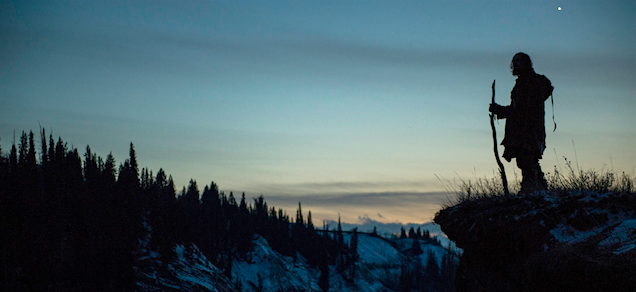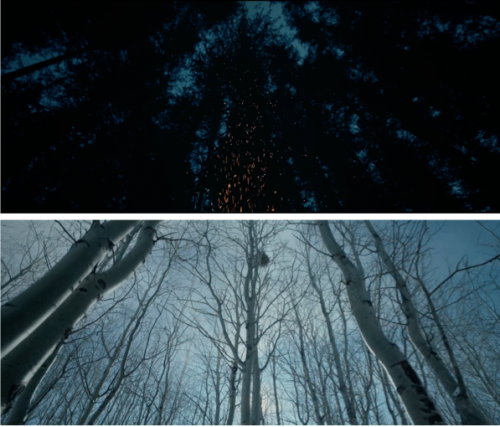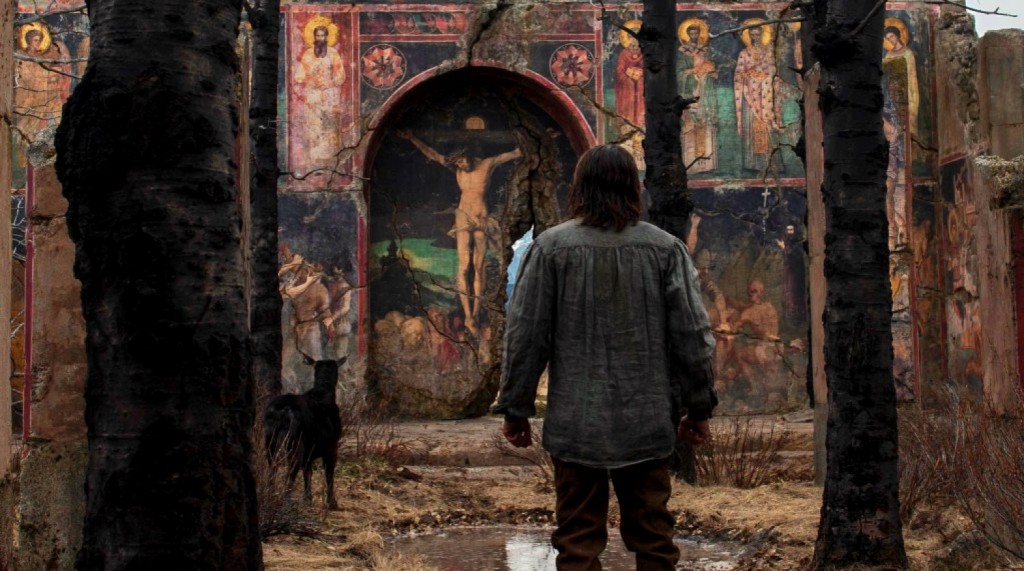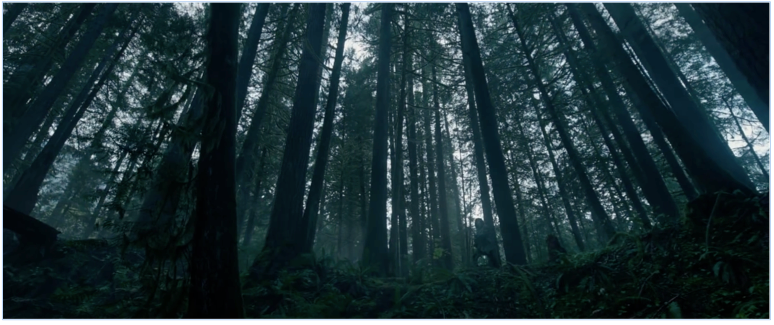
A brilliant look at The Revenant, from our friend Caleb Stallings.
 Being a native of Georgia, I’ve always been oddly proud of our pine trees. Up until the recent film industry boom in Atlanta, I felt like the Peach State had few cultural icons to offer, the pine tree being a (less than) obvious exception. Whether Ray Charles was glimpsing that romantic moonlight between them, or Johnny Cash was reveling in their incomparable heights, the Georgia pine has long stood as a symbol of strength, power, and even transcendence. In Alejandro Iñárritu’s most recent film, The Revenant, the pine in particular, and the tree in general, serve similar purposes. But Iñárritu’s stunning film uses these common features of the landscape to fill a very uncommon purpose: standing as or accentuating the symbol of a priest.
Being a native of Georgia, I’ve always been oddly proud of our pine trees. Up until the recent film industry boom in Atlanta, I felt like the Peach State had few cultural icons to offer, the pine tree being a (less than) obvious exception. Whether Ray Charles was glimpsing that romantic moonlight between them, or Johnny Cash was reveling in their incomparable heights, the Georgia pine has long stood as a symbol of strength, power, and even transcendence. In Alejandro Iñárritu’s most recent film, The Revenant, the pine in particular, and the tree in general, serve similar purposes. But Iñárritu’s stunning film uses these common features of the landscape to fill a very uncommon purpose: standing as or accentuating the symbol of a priest.
The movie begins with our intrepid protagonist, Hugh Glass (Leonardo DiCaprio), experiencing a haunting, yet sublime memory of his family gathering around a solitary tree in a vast field. The tree is both comforting and foreboding, revealing his innermost desire for his family and the aching regret that unfolds over the rest of the movie. This lonely tree hearkens back to the two trees encountered in the biblical book of Genesis. On the one hand, it’s the tree of life, exuding the comforting grace of community and love. But on the other, it’s the tree of the knowledge of good and evil, casting a dark shadow of death and sorrow that darken the following chapters of Glass’ life. This single tree defines the prologue of the film while providing a symbolic monolith to which the movie often hearkens back. Simultaneously, this tree reminds us of the long and winding biblical narrative involving a Fall and death and redemption and Life. The symbolic power of the tree ultimately becomes underscored by its death-dealing, life-giving purpose in the film.
The story of The Revenant, broadly speaking, is a story of betrayal, survival, and revenge in the middle of a massive wilderness, populated with nothing but danger from every side. Be it wild bears, Native American warriors, sub-zero temperatures, or worst of all, vicious traitors, Glass faces it all. Beyond the personal drama, the film’s setting represents an overarching schema of human history. This world, as everyone of us can attest, is one of lonely wandering with danger at every turn and in every decision. Life is often all too easily comparable to trekking through a savage wilderness in a blinding snowstorm amidst the constant threat of betrayal.
Yet at the forefront of all this brutal and loveless imagery we find the ubiquitous presence of pine trees. Iñárritu and cinematographer, Emmanuel Lubezki, often angle the camera upwards from the snow drifts. We are not only privy to the desperate faces of Glass and his fur trappers, but to right above their heads: the tops of the pine trees. These trees are always shown to be extending their branches and needles ever upwards to the heavens while being firmly planted in the earth below. And just as these trees occupy two spheres, so do they seem to take varying sides in human conflict. In the beginning, for instance, the trees not only serve as shields for Glass’ comrades, but as towers from which the Pawnee rain down their deadly arrows. In other words, the trees themselves provide salvation as much as they deal out wrath. Always there, never neutral.
After a narrow escape from Pawnee, Glass is terribly injured in a gruesome bear attack. Much of his early screen time, therefore, is spent on his back, looking upwards into the trees. Sometimes they bring omens of good, and sometimes of ill. But they are always there for his and our contemplation.
In one scene, Glass is comforted by his slain Pawnee bride, as she appears in the middle of the forest, her ghostly image floating down from the treetops over his pain-wracked body. In some mystical way, these trees connect the afterlife to this present life. From heaven to earth. She speaks words of comfort and deliverance to him in these moments. As she hovers in the midst of the pines, her spirit reminds him of that one tree in the beginning of the film. She tells him how, when he looked at its branches, he would almost certainly think that it was liable to collapse at any moment. But she further reminds him, “The stability of the tree is in its root.” The tree that reaches into the untouchable sky is firmly anchored to the world below. Its role is priestly, connecting the human to the divine; the physical to the spiritual; the temporal to the eternal.
The priestly imagery doesn’t end there. Just as there are varying interpretations of that one tree, so are there two characters that embody the priestly role. The first priest, a wicked one, is John Fitzgerald (Tom Hardy), who tries to kill and abandon the infirmed Glass so that he might survive and take Glass’ share of the pelt profits. Glass’ son, Hawk, tries to intervene, but in a fit of rage, Fitzgerald murders him. As Glass begins to recover enough to make his way back to civilization, particularly to right this wrongful killing, he encounters a solitary and sympathetic Pawnee hunter/healer called Hikuc (Arthur Redcloud). Hikuc, too, is a priestly character, but worlds apart from Fitzgerald. Fitzgerald is outspokenly pious but inwardly deviant–somewhat reminiscent of the unrighteous religious leaders who oppose Jesus throughout the gospels. But Hikuc’s origins are more mysterious, reminiscent of Melchizedek, the king-priest of Genesis who facilitates Abraham’s worship of Yahweh.

First, we have the false priest, Fitzgerald, who offers to administer his own aberrant version of the Catholic sacrament of last rites to the injured Glass, most notably by suffocating him against his will and stealing his share. And this is only the beginning of Fitzgerald’s abominable priesthood. In two separate scenes, he rambles about the Lord’s will, once just before trying to take the life of a teenage boy who opposes him, and later when he is face to face with Glass’ fearsome vengeance. In both scenes, he claims to know God’s will, which to him looks a lot like profiteering and murder. But Fitzgerald’s most telling scene is when he cynically describes to the boy he previously tried to kill how his father found true religion in the middle of a similarly brutal winter. “He found God… and God’s a squirrel.” Then, as if to complete his irreverent sacramentology, he laughs as he mockingly reports how his father ate God when he ate the squirrel. The irony, of course, comes from the fact that the God whom Fitzgerald uses to his own ends is actually the same God who generously gives himself to be eaten in the bread of his own body.
This wicked priest imagery is reversed by the Pawnee tribesman, Hikuc, who counters the anti-Christ words and deeds of Fitzgerald with wisdom and love. After feeding and nursing Glass in the middle of a particularly dark night, he listens to his patient’s story of betrayal and destruction. When Glass explains that his son was killed by Fitzgerald, Hikuc both sympathetically and wisely responds, “My heart bleeds. But revenge is in the Creator’s hands.” His advice is followed up with grace as he takes a very helpless Glass with him on his horse.
During Glass’ time with Hikuc, he finds the old, abandoned ruins of a frontier church. Iñárritu shows us a particularly stunning juxtaposition of images within the church, most notably the faded painting of Jesus on the cross. Glass enters the church somberly and looks around to observe the stark contrast of the sacred images being consumed by flourishing plant life. Suddenly, he is in the midst of another vision, this time one involving his slain son. Hawk is looking at the picture of Jesus at the front of the sanctuary before he turns to walk towards his father. Once the two embrace, Glass awakens from his vision to find himself holding a large pine tree growing right in the center of the ruins. Life springs from death.

The ruins of religion, summed up by Fitzgerald, give way for the living grace that Hikuc embodies. The weight of his despair finally begins to lift at the foot of this tree. And interestingly, that tree is no longer flatly represented on the wall of a vacant church, but it is real and tangible. The tree’s stability is indeed in its root, against which Glass now so desperately leans. Hikuc, the Melchizedek figure, has led him to a sacred reckoning with the Greater Melchizedek. And the stunning imagery only compounds from there.
As Glass’ body finally fails under the weight of his own injuries, Hikuc saves his life by building a healing tent in which he may recover, while Hikuc instead braves the terrible wrath of a snowstorm. When Glass emerges, he finds that his savior (the very one with whom he had previously enjoyed the unifying sacrament of catching snowflakes on the tongue) has been hanged from a tree, bearing the a sign that reads “savage.” While the tree in the church revealed the reconciliatory part of Glass’ salvation, this other tree now shows the audience the propitiatory aspect of it. This so-called “savage” now hangs from a tree, seemingly cursed with an ironic signpost calling him, the healer, “a savage.” But it was this very “savage” that saved Glass’ life by healing his wounds and cheering his spirit. Upon seeing this, my mind sprang to Galatians 3 in which Paul reminds Christians: “Christ redeemed us from the curse of the law by becoming a curse for us—for it is written, ‘Cursed is everyone who is hanged on a tree’” (ESV).
Thus, the circle begins to close for viewers. The ominous/promising tree in the beginning of the film has found a salvific terminal. And how reminiscent this paradoxical imagery is of the biblical narrative. In it, we find a man condemned by a tree, and much later, we find another Man being condemned for the sake of the first on a different tree. We also find relentlessly cruel religious leaders, not unlike John Fitzgerald, claiming some esoteric access to God, but acting without either grace or justice. In contrast, we also find one, not unlike Hikuc, who loves and forgives the sinner, and for it, hangs on a cursed tree as a criminal with a mocking sign above his head: “King of the Jews.” The irony of Hikuc’s sign is that he is not actually the savage, but the greater irony of Jesus’ sign is that he actually is the King.
 When Glass does finally meet Fitzgerald and squares off with him, we see that, even in his flawed character, Glass is a changed man. As Fitzgerald screams in a bout of irreverent panic, “The Lord knows what happened out there! … You came for revenge, but ain’t nothing gonna bring your boy back!” Glass calmly retorts, “Revenge is in God’s hands, not mine.” He then allows Fitzgerald to wash down river where he meets his end at the hands of the very Pawnee natives he so viciously hates.
When Glass does finally meet Fitzgerald and squares off with him, we see that, even in his flawed character, Glass is a changed man. As Fitzgerald screams in a bout of irreverent panic, “The Lord knows what happened out there! … You came for revenge, but ain’t nothing gonna bring your boy back!” Glass calmly retorts, “Revenge is in God’s hands, not mine.” He then allows Fitzgerald to wash down river where he meets his end at the hands of the very Pawnee natives he so viciously hates.
I think it was Roger Ebert who cleverly said that one can tell how good a movie is by how long you are still thinking about it after you saw it. For me, The Revenant has loomed large for days now. Part of that, of course, is due to its haunting cinematography, stunning performances, and nearly unbelievable story. But above all, I cannot shake the images of those pines. They connected heaven and earth. They dealt death from above and provided shelter from below. They gave one man lost in a hopeless winter tundra a place to lean and to live. And they reminded me that a priest hanging from a tree is everything in the world I’ve ever needed.

COMMENTS
4 responses to “The Cursed Tree and the High Priest: The Christ Imagery of The Revenant”
Leave a Reply














The war-party that attacked the Americans were the Ree, not the Pawnee (who were Hikuc and Hawk’s nation).
I’m not sure I buy the reading, but I appreciate the effort to connect the trees, the God-talk, and the strange chapel scene. Thanks for writing this!
Great connections made here. Not sure it was intentional on Iñárritu’s part but interesting to think how the Biblical narrative is so woven into our world, it just can’t help but leak out in cultural artistic “offerings” such as film. 🙂